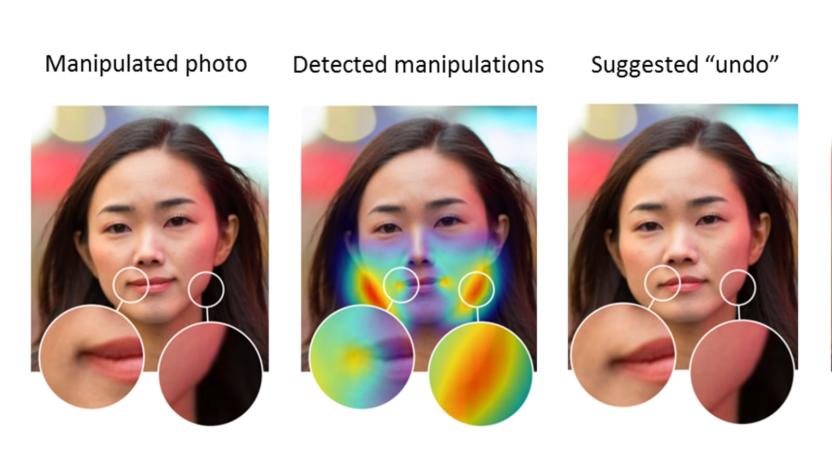detection
Latest

Students develop a smart bra for early breast cancer detection
Students from the Swiss university EPFL have developed a smart bra designed to detect breast cancer in its earliest stages. They believe it's the first piece of clothing that can be used for cancer prevention. They even claim that it's comfortable and that the tech is "nearly imperceptible."

Moen's voice-activated faucet gives cooks precise amounts of water
Moen, one of the biggest faucet companies in the US, was last spotted at CES showing off its shower "concierge," but now it's turning its attention to more traditional sink fixtures. This year, it announced the U by Moen Smart Faucet -- a voice-activated faucet that helps you do everyday kitchen tasks hands-free. From preparing a baby's bottle to filling a pasta pot, just tell the faucet how much water you need, and at what temperature, and it'll dispense it on command. You can set unlimited personalized presets for specific cooking tasks, and activate water flow through voice control, a wave sensor, or via a good old fashioned button. Moen hasn't announced pricing for its latest addition, but it's likely to cost a substantial amount more than old-fashioned mechanical faucets.

Facebook will train its content-removal AI with police camera footage
Facebook will use footage from police body cameras to train its automatic detection systems to spot and remove footage of mass shootings. The company announced Tuesday that it will partner with law enforcement in the US and UK to obtain footage from their firearms training programs. Data from those videos should help Facebook's systems detect real-world, first-person footage of violent events.

DeepMind AI can predict kidney illness 48 hours before it occurs
Acute Kidney Injury (AKI) kills 500,000 people in the US and 100,000 in the UK annually, often because it's not detected soon enough. Researchers want to use AI to change that. DeepMind, the Alphabet-owned AI company, partnered with the US Department of Veterans Affairs (VA) to develop an AKI prediction algorithm. In a paper published in Nature today, the partners share their findings that the algorithm can predict the presence of AKI up to 48 hours before it happens. The model correctly identified 9 out of 10 patients whose condition worsened to the point that they needed dialysis.

Adobe trained AI to detect facial manipulation in Photoshop
A team of Adobe and UC Berkeley researchers trained AI to detect facial manipulation in images edited with Adobe Photoshop. The researchers hope the tool will help restore trust in digital media at a time when deepfakes and fake faces are more common and more deceptive. It could also democratize image forensics, making it possible for more people to uncover image manipulation.

Google trained its AI to predict lung cancer
Of all cancers worldwide, lung cancer is the deadliest. It takes more than 1.7 million lives per year -- more than breast, prostate and colorectal cancer combined. Part of the problem is that the majority of cancers aren't caught until later stages, when interventions tend to be less successful. Google is determined to change that, and with its new AI-based tool, it hopes to make lung cancer prediction more accurate and more accessible.

WiFi mesh networks can detect your breathing
In the world of indoor security systems, motion detection usually relies on cameras or at least dedicated sensors. Both types of solution add to hardware plus installation costs, not to mention that not everyone is comfortable with having cameras pointing at them all the time. Origin Wireless, on the other hand, found a way to make use of WiFi signals bouncing around a room to detect even the slightest movement -- down to something as subtle as a person's breathing rate. What's more, this "Time Reversal Machine" technology is essentially just some clever algorithmic work with little burden on the processor, so it can potentially be added to any existing WiFi mesh routers via a firmware update. In other words, security system vendors should take note.

Logitech's Circle camera can better distinguish people from pets (updated)
The ability to determine the difference between an actual person and a pet or other wildlife can be an issue for some connected security cameras. With an update to its Circle camera, Logitech improves the device's ability to do just that. The company says the camera employs "proprietary artificial intelligence" to identify when someone is approaching. Of course, this should cut down on any unwanted alerts when your cat saunters by.

Future Range Rovers could tell the city about local potholes
Jaguar Land Rover has revealed that it's working on technology that'll alert the authorities whenever your car finds a bump in the road. It's one of several high-tech initiatives the outfit has been working on, including heads-up displays in the windshield and "transparent" cars. Once an issue, like a pothole or broken drain, has been discovered, its location will be uploaded to the authorities who can then send a maintenance crew to come fix it. In the meantime, the information can be shared with nearby vehicles so that motorists in the vicinity can avoid damaging their car.

Samsung engineers are working on wearable for early stroke detection
Samsung has quite the diverse family of products, and for the last two years, a team of engineers have been working on yet another. Folks from its smartphone and washing machine teams are building a wearable sensor that monitors brainwaves to detect the early stages of a stroke. The result is a prototype known as the Early Detection Sensor and Algorithm Package (EDSAP): a device that keeps tabs on the electric impulses of the brain with the help of a smartphone or tablet. In theory, the sensor-packed headset will alert folks who are at risk for a stroke early on, so they can get to a doctor to prevent potentially serious and permanent effects. The EDSAP's tech collects brainwave info and beams it wirelessly to the companion device, determining the chances of a stroke within 60 seconds. What's more, when used for longer sessions, the setup can analyze neurological health in terms of stress, anxiety and sleep patterns.

LG banner ads detect your Galaxy S 4 or iPhone in order to bash it
Ad agency M&C Saatchi has come up with a rather dubious but clever way of marketing LG's G2 smartphone. Its banner ads sense your own handset and will taunt its shortcomings while suggesting, naturally, an LG G2 instead. For instance, an HTC One-based ad suggests that you'll get 30 percent more battery life with a G2, while an iPhone version touts the LG's larger screen. The Sweden-only ads may rub brand-loyal types the wrong way, but as an attention-grabbing device? LG does know trolling.

Encrypted Text: Answering your post-5.0.4 rogue questions
Every week, WoW Insider brings you Encrypted Text for assassination, combat and subtlety rogues. Chase Christian will be your guide to the world of shadows every Wednesday. Feel free to email me with any questions or article suggestions you'd like to see covered here. Patch 5.0.4 might not have brought all of Mists of Pandaria's content, but it did contain all of its mechanics and class changes. Our new talent trees are active and Swirly Ball has finally returned. As with all of the pre-expansion patches, we are given a few weeks to cope with the new changes before the actual expansion goes live. While we're still missing out on our level 87 abilities and our level 90 talents, we still need to be able to deftly control our rogues for a few more weeks. The majority of our rotations have remained intact, and you should feel right at home after a few cycles. Most of the changes that rogues are seeing are passive or quality of life improvements. Other classes are faced with relearning major facets of their playstyle, but combo points and energy continue to hold steady.

Rogue glyph changes in patch 5.0.4
When the new 5.0 patch flips over on Aug. 28, will you be ready with glyphs? Blizzard is recycling old glyphs instead of making new spell IDs and charring old ones. Some glyphs are staying the same, some are new, but some share IDs with old Cataclysm glyphs. Below is our list of new or changing glyphs for rogues. This is not a list of changing tooltips, just which glyphs you ought to have if you want to automatically have the new glyphs when the patch flips over. Rogues have no brand new glyphs and are keeping most glyph names. Glyphs that are changing into new majors: Sinister Strike becomes Adrenaline Rush Rupture becomes Cheap Shot Fan of Knives becomes Deadly Momentum Eviscerate becomes Debilitation Revealing Strike becomes Detection Deadly Throw becomes Recuperate Adrenaline Rush becomes Shadow Walk Slice and Dice becomes Shiv Preparation becomes Smoke Bomb Shadow Dance becomes Stealth Glyphs that are changing into new minors: Backstab becomes Decoy Mutilate becomes Disguise It's open warfare between Alliance and Horde in Mists of Pandaria, World of Warcraft's next expansion. Jump into five new levels with new talents and class mechanics, try the new monk class, and create a pandaren character to ally with either Horde or Alliance. Look for expansion basics in our Mists FAQ, or dig into our spring press event coverage for more details!

MIT's laser-powered camera can detect objects hidden around corners (video)
One of the most thrilling things about human existence is that you never know what's lurking around the corner. It could be a newborn baby, a sweet job, a delicious churro -- doesn't really matter, because it's a surprise, and surprises are fun and surprising. Just don't tell that to the doldrum dwellers over at MIT, because apparently, they don't agree. The same team that created a camera with light-speed shutter rates has now expanded upon their project, with a camera capable of seeing around corners. Literally. To do this, the system uses a so-called femtosecond laser to send out extremely short light pulses -- so short, in fact, that their entire lifespan is measured in quadrillionths of a second. To capture an object lurking around a corner, the device aims its laser at a nearby wall, thereby allowing the light to bounce around the room before eventually landing on the concealed object. Once it hits the jackpot, the light will reflect back onto the wall, and eventually return to a detector, which can gauge the exact location of the object based on the distance the laser traveled. This happens over and over again at different angles, meaning that the system will ultimately be able to get a general idea of the hidden room's layout. Researchers hope that their system will eventually be used in emergency rescue situations, or to help drivers see what's around the bend, though there's no telling when any of that could actually happen. For a diagrammatic rundown, check out the video after the break.

MechWarrior Online fights with knowledge as well as lasers
In any combat situation it is key to be as well-informed as possible: to know where your enemy is (hopefully not right behind you), what resources you have on hand (dual Twinkies), what you're up against (spouse aggro), and so on. The makers of the upcoming MechWarrior Online have devoted their second dev blog to the importance of information -- or as they put it, "knowledge is power!" To aid with information warfare, the designers will provide to players a key tool called a BattleGrid, which will function like a pumped-up interactive map during in-game conflicts. Through the BattleGrid, players will be able to get a good idea of what's going on in the field quickly and what orders are coming through for the attack. The blog post also mentions the concept of "modules" that allow pilots to customize their 'Mechs, and it gives a brief overview of the line-of-sight targeting system and how players can work together to share battlefield information as well as how they can confuse the enemy. Hiding and seeking in the game will require a good combination of both detection and "spoofing" modules to keep your team alive while exposing the opposite one. [Thanks to Nimsy for the tip!]

New bomb-sniffing laser could be used to locate IEDs
We've already seen lasers with the potential to spot explosives, and now a team of researchers is focusing its beams on roadside bomb detection. Chemistry professor Marcos Dantus of Michigan State University has led the production of a laser that has the "sensitivity and selectivity" to accurately identify improvised explosive devices. This particular bomb-sniffing laser emits short pulses that make molecules vibrate and longer pulses used to "listen" to the resulting "vibrational cords," these so-called cords are used to distinguish telltale molecules from the harmless sort. The research is being funded in part by the Department of Homeland Security. Full PR after the break.

Sprint radar imaging system peeps inside walls, floors to detect bombs, tell-tale hearts
Back in 2005, we reported on a little something called the Prism 200, which allowed its holder to essentially see what folks were doing on the other side of a wall. Since then, we've seen plenty of devices that boast the same claims, but it wasn't until recently that the makers of the Prism 200 created a device that can actually see inside those walls. Looking something akin to an old school punch clock, Cambridge Consultants' Sprint in-wall radar imaging system provides 3D renderings of items embedded in walls, floors, and even ceilings. Where as existing X-ray systems require access to both sides of a wall, Sprint's radar setup allows users to see what's going on inside without dual access. As you might imagine, Cambridge is pushing this thing as a security tool, allowing for detection of bombs, drugs, dead bodies -- you know, the usual bad guy stuff. Sprint is currently undergoing testing. Full PR after the break.

Carbon nanotubes used to more easily detect cancer cells, HIV
Cancer's not slowing its march to ruining as many lives as it possibly can, so it's always pleasing to hear of any new developments that act as hurdles. The latest in the world of disease-prevention comes from Harvard University, where researches have created a dime-sized carbon nanotube forest (read: lots of nanotubes, like those shown above) that can be used to trap cancer cells when blood passes through. A few years back, Mehmet Toner, a biomedical engineering professor at Harvard, created a device similar to the nano-forest that was less effective because silicon was used instead of carbon tubes. Today, Toner has teamed up with Brian Wardle, associate professor of aeronautics and astronautics at MIT, who together have redesigned the original microfluid device to work eight times more efficiently than its predecessor. The carbon nanotubes make diagnosis a fair bit simpler, largely because of the antibodies attached to them that help trap cancer cells as they pass through -- something that's being tailored to work with HIV as well. Things are starting to look moderately promising for cancer-stricken individuals, as hospitals have already began using the original device to detect malignant cells and ultimately prevent them from spreading -- here's hoping it's qualified for mass adoption sooner rather than later.

US Army to deploy Individual Gunshot Detector, essentially a radar for bullets
Latest in our series of "when video games turn real," here's the US Army's newest addition to the wargadget arsenal. The Individual Gunshot Detector, produced by QinetiQ, is an acoustic monitor attuned to tracking down the source of gunshots just by their sound. It has four sensors to pick up the noise of incoming fire, and its analysis of those sound waves produces a readout on a small display that lets the soldier know where the deadly projectiles originated from. The entire system weighs just under two pounds, and while it may not be much help in an actual firefight -- there's no way to distinguish between friendly and hostile fire -- we imagine it'll be a pretty handy tool to have if assaulted by well hidden enemies. 13,000 IGD units are being shipped out to Afghanistan later this month, with a view to deploying 1,500 each month going forward and an ultimate ambition of networking their data so that when one soldier's detector picks up a gunfire source, his nearby colleagues can be informed as well.

Microsoft's OneVision Video Recognizer can detect, identify, and track your face on video... so smile!
Here's your classic case of "just because you can, doesn't mean you should." Microsoft's Innovation Labs have just demonstrated a OneVision Video Recognizer algorithm that's powerful enough to perform face detection duties on a running video feed. It can recognize and track humanoid visages even while they're moving, accept tags that allow auto-identification of people as they enter the frame, and can ultimately lead to some highly sophisticated video editing and indexing via its automated information gathering. Of course, it's that very ease with which it can keep a watchful eye on everyone that has us feeling uneasy right now, but what are you gonna do? Watch the video after the break, that's what.









